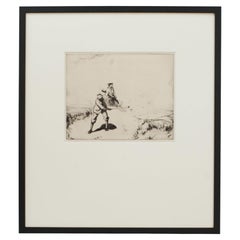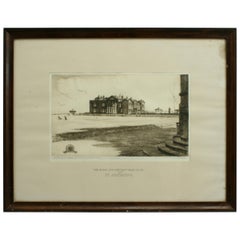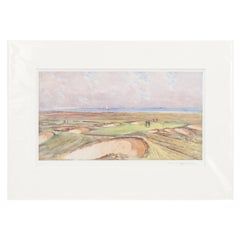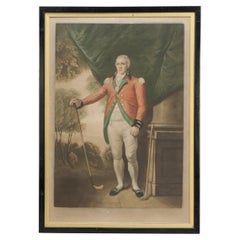Want more images or videos?
Request additional images or videos from the seller
1 of 3
Golfing Picture, Dry Point Etching by John R. Barclay
$1,140.26List Price
About the Item
- Dimensions:Height: 8.08 in (20.5 cm)Width: 10.04 in (25.5 cm)Depth: 0.04 in (1 mm)
- Place of Origin:Scotland
- Period:
- Date of Manufacture:circa 1922
- Condition:
- Seller Location:Oxfordshire, GB
- Reference Number:Seller: 259481stDibs: LU97574410813
About the Seller
5.0
Platinum Seller
Premium sellers with a 4.7+ rating and 24-hour response times
Established in 1977
1stDibs seller since 2013
817 sales on 1stDibs
Typical response time: 1 hour
Associations
LAPADA - The Association of Arts & Antiques Dealers
Authenticity Guarantee
In the unlikely event there’s an issue with an item’s authenticity, contact us within 1 year for a full refund. DetailsMoney-Back Guarantee
If your item is not as described, is damaged in transit, or does not arrive, contact us within 7 days for a full refund. Details24-Hour Cancellation
You have a 24-hour grace period in which to reconsider your purchase, with no questions asked.Vetted Professional Sellers
Our world-class sellers must adhere to strict standards for service and quality, maintaining the integrity of our listings.Price-Match Guarantee
If you find that a seller listed the same item for a lower price elsewhere, we’ll match it.Trusted Global Delivery
Our best-in-class carrier network provides specialized shipping options worldwide, including custom delivery.You May Also Like
Vintage Dry Point Etching "Bison" by Józef Hecht
By Józef Hecht
Located in San Diego, CA
Vintage dry point etching "Bison" by noted artist Józef Hecht, circa 1930s. The piece is hand signed and titled in pencil by the artist and numbered 18 of 40 in the lower left. The i...
Category
Early 20th Century French Drawings
Materials
Paper
American Dry Point Engraved Etching Italian House on Hill Side, A. Hutty C 1920
By Alfred Hutty
Located in Charleston, SC
American dry point engraved landscape etching Italian House on Hill Side, Alfred H. Hutty, Early 20th century
Category
Vintage 1920s American Modern Drawings
Materials
Paper
$2,800
H 9 in W 11.25 in D 1 in
James Jacques Joseph Tissot "Soirée d'été" 'Summer Evening' Etching & Dry Point
By James Tissot
Located in Los Angeles, CA
A fine French 19th century etching and drypoint Titled "Soirée d'été" (Summer Evening) by Jacques Joseph Tissot (French, 1836-1902) depicting Mrs. Kathleen Newton resting on a lounge chair. Signed and dated (l/l): J.J. Tissot, 1881 in the plate. Under the mat, the front of the sheet inscribed in pencil with a '1' in a circle, the verso of the sheet with old price inscription "450-" in pencil. Circa: 1881-1882.
Measures: Plate Height: 9 inches (22.9 cm)
Plate Width: 15 1/2 inches (39.4 cm)
Sheet Height: 14 1/2 inches (36.8 cm)
Sheet Width: 20 5/8 inches (52.4 cm)
Frame Height: 19 inches (48.3 cm)
Frame Width: 24 1/2 inches (62.2 cm)
Frame Depth: 1 1/8 inches (2.9 cm)
Literature:
Wentworth 56. Note: Tissot's from 1881 is said to depict his lover, the Irish divorcee Mrs. Kathleen Newton, resting on a lounge chair.
Provenance:
Private collection, Los Angeles, California
Jacques Joseph Tissot (French, 15 October 1836 – 8 August 1902), Anglicized as James Tissot, was a French painter and illustrator. He was a successful painter of Paris society before moving to London in 1871. He became famous as a genre painter of fashionably dressed women shown in various scenes of everyday life. He also painted scenes and characters from the Bible.
Jacques Tissot was born in the city of Nantes in France and spent his early childhood there. His father, Marcel Théodore Tissot, was a successful drapery merchant. His mother, Marie Durand, assisted her husband in the family business and designed hats. A devout Catholic, Tissot's mother instilled pious devotion in the future artist from a very young age. Tissot's youth spent in Nantes likely contributed to his frequent depiction of shipping vessels and boats in his later works. The involvement of his parents in the fashion industry is believed to have been an influence on his painting style, as he depicted women's clothing in fine detail. By the time Tissot was 17, he knew he wanted to pursue painting as a career. His father opposed this, preferring his son to follow a business profession, but the young Tissot gained his mother's support for his chosen vocation. Around this time, he began using the given name of James. By 1854 he was commonly known as James Tissot; he may have adopted it because of his increasing interest in everything English.
In 1856 or 1857, Tissot travelled to Paris to pursue an education in art. While staying with a friend of his mother, painter Elie Delaunay, Tissot enrolled at the Ecole des Beaux-Arts to study in the studios of Hippolyte Flandrin and Louis Lamothe. Both were successful Lyonnaise painters who moved to Paris to study under Jean-Auguste-Dominique Ingres. Lamothe provided the majority of Tissot's studio education, and the young artist studied on his own by copying works at the Louvre, as did most other artists of the time in their early years. Around this time, Tissot also made the acquaintance of the American James McNeill Whistler, and French painters Edgar Degas (who had also been a student of Lamothe and a friend of Delaunay), and Édouard Manet.
In 1859, Tissot exhibited in the Paris Salon for the first time. He showed five paintings of scenes from the Middle Ages, many depicting scenes from Goethe's Faust. These works show the influence in his work of the Belgian painter Henri Leys (Jan August Hendrik Leys), whom Tissot had met in Antwerp earlier that same year. Other influences include the works of the German painters Peter Von Cornelius and Moritz Retzsch. After Tissot had first exhibited at the Salon and before he had been awarded a medal, the French government paid 5,000 francs for his depiction of The Meeting of Faust and Marguerite in 1860, with the painting being exhibited at the Salon the following year, together with a portrait and other paintings.
Émile Péreire supplied Tissot's painting Walk in the Snow for the 1862 international exhibition in London; the next year three paintings by Tissot were displayed at the London gallery of Ernest Gambart.
In about 1863, Tissot suddenly shifted his focus from the medieval style to the depiction of modern life through portraits. During this period, Tissot gained high critical acclaim, and quickly became a success as an artist. Like contemporaries such as Alfred Stevens and Claude Monet, Tissot also explored Japonisme, including Japanese objects and costumes in his pictures and expressing style influence. Degas painted a portrait of Tissot from these years (Metropolitan Museum of Art, New York), in which he is sitting below a Japanese screen hanging on the wall.
Still on Top, 1873
Tissot fought in the Franco-Prussian War as part of the improvised defense of Paris, joining two companies of the Garde Nationale and later as part of the Paris Commune. His 1870 painting La Partie Carrée (The Foursome) evoked the period of the French revolution. Either because of the radical political associations related to the Paris Commune (which he was believed to have joined mostly to protect his own belongings rather than for shared ideology), or because of better opportunities, he left Paris for London in 1871. During this period, Seymour Haden helped him to learn etching techniques. Having already worked as a caricaturist for Thomas Gibson Bowles, the owner of the magazine Vanity Fair, as well as exhibited at the Royal Academy, Tissot arrived with established social and artistic connections in London. Tissot used...
Category
Antique Late 19th Century French Victorian Drawings
Materials
Glass, Wood, Paper
$4,985 Sale Price
22% Off
H 19 in W 24.5 in D 1.13 in
4 Etchings by WG Beal, Marblehead, Rock Port, Folly Point & Annisquam, 1880's MA
Located in Bedford Hills, NY
Set of four etchings by American artist William Goodrich Beal, circa 1880s. Scenic Massachusetts coastal towns and beaches. All signed in ...
Category
Antique 1880s American American Classical Prints
Materials
Paper
$4,000 / set
H 12 in W 16 in D 0.01 in
1828 Egnlish Massa Out “Sambo Werry Dry” Mezzotint Etching By Henry Pidding
Located in Van Nuys, CA
Late Georgian period Mezzotint Etching print By English Artist Henry Pidding titled Massa Out “Sambo Werry Dry”. The print features a young man seated by a table on which are keys ma...
Category
Antique 1820s Romantic Drawings
Materials
Paper
$2,295
H 18 in W 23 in D 2 in
Water Color of the Cambridge Skyline Signed Barclay
By John Rankin Barclay
Located in Vancouver, British Columbia
An atmospheric impressionist style water colour of the skyline of the English University Town of Cambridge all done in pastel inspired colours. The work is boldly signed Barclay at t...
Category
Antique Late 19th Century English Other Drawings
Materials
Paper
Watercolor by John Varley, 1812
By Ernest William Varley
Located in Kittery Point, ME
'Llanberis Lake at the Foot of Mount Snowdon' in Wales.
Watercolor on paper, signed and dated "J. Varley 1812" ll, identifying info on verso.
sight size: 8 x 19 3/4 in.
John Varley is known as an English landscape painter in watercolor and a close friend of William Blake. Varley represents the transition between tinted topographical drawing and the bolder, more fully developed manner of watercolor painting characteristic of the 19th century. As well as being a leading painter, he was the most popular and enthusiastic teacher of his day: his pupils included Cox, De Wint, Linnell, Mulready (his brother-in-law), and Samuel Palmer, and he published various instructional works, including one with Blake.
In his early years Varley was influenced stylistically by the work of Thomas Girtin...
Category
Antique 1810s English Neoclassical Drawings
Materials
Paper
1922 Drawing by Grace Spaulding John
Located in Houston, TX
1922 Drawing by listed Artist Grace Spaulding John "The Knotless Thread" Has article and a letter to whom the drawing was given, including bonus sketches.
GRACE SPAULDING JOHN (1890...
Category
Early 20th Century American Art Deco Drawings
Materials
Paper
"Two Nudes" Signed by John Carroll
By John Carroll Doyle
Located in Toledo, OH
"Two Nudes" Signed by John Carroll. John Carroll (1892-1959) Kansas City, KS. Circa 1928-1929. Lithograph on Chine de Colle. Also known as "Two Girls A...
Category
Mid-20th Century American Drawings
Materials
Paper
Władysław Zakrzewski, etching "Autumn by the River".
Located in Chorzów, PL
Władysław Zakrzewski - In the years 1922-1924 he studied at the Academy of Fine Arts in Kraków under the supervision of Władysław Jarocki and Józef Pankiewicz, and in the years 1926-...
Category
Vintage 1930s Polish Other Drawings
Materials
Paper
$377 Sale Price
20% Off
H 14.57 in W 18.51 in D 1.19 in
More From This Seller
View AllGolf Etching By J.R. Barclay, Sand.
By John Rankin Barclay
Located in Oxfordshire, GB
Golfing Picture, Drypoint Etching by John R. Barclay.
A black and white etching of a golfer playing out of the dunes whilst watched by his playing partner. The fine original dry poin...
Category
Early 20th Century British Sporting Art Decorative Art
Materials
Paper
St Andrews Golf Club, Bicentenary Etching, Ltd Edition 10/75
Located in Oxfordshire, GB
St Andrews golf club bicentenary etching.
A rare etching of the Royal and Ancient Golf Club St Andrews Clubhouse, produced as Ltd. edition for the...
Category
Mid-20th Century British Sporting Art Drawings
Materials
Paper
Signed Harry Rountree Golf Picture, Princes Golf Club.
Located in Oxfordshire, GB
Vintage Harry Rountree Golf Print, Princes GC, Kent.
Signed Princes GC golf print after H. Rountree. This is a photolithograph of 'Princes GC, Kent' with the White Cliffs further alo...
Category
Early 20th Century British Sporting Art Prints
Materials
Paper
Henry Callender, Golf Picture, Mezzotint
Located in Oxfordshire, GB
Golf Picture, Henry Callender ESQ.
Framed golf mezzotint of 'Henry Callender Esq' (Captain of the society of Golfers at Blackheath) after a painting by Lemuel Francis Abbott (1760 - 1803). The colourful print signed in pencil by the engraver Will Henderson...
Category
Early 20th Century British Sporting Art Paintings
Materials
Wood, Paper
Golf Etching Of St Andrews By Wyllie
Located in Oxfordshire, GB
St Andrews Golf Etching by W.L. Wyllie.
A very charming etching of two children playing golf on the beach at St Andrews, in the background is the town of St Andrews with the Castle &...
Category
20th Century British Decorative Art
Materials
Paper
Golf Painting by John Blair, Craigmillar Park G C
Located in Oxfordshire, GB
Craigmillar Park Golf Club Watercolour, John Blair.
An atmospheric original watercolour of Craigmillar Park Golf Links in Edinburgh by the Scottish artist John Blair (1849-1934). Craigmillar Castle from which the club derives its name from is clearly seen in the background and the painting is signed to the lower left corner. Craigmillar Castle was a haunt of Mary Queen of Scots, the world's first recorded lady golfer. How ironic then, that since the golf club's inception equality of the sexes was the rule at Craigmillar Park.
John Blair was a Scottish painter, predominantly of watercolour landscapes. Of humble beginnings in Berwickshire, he moved to Edinburgh to study and spent the rest of his life there. His paintings mainly reflect the landscapes around him, both of urban settings and also of the castles, sea and lochs of the Borders. As well as his original work, his paintings were viewed by a wide audience in the form of picture postcards, book endpapers and illustrations.
Taken from Craigmillar Park Golf Club website:-
Craigmillar Park Golf Club was constituted in 1895 and moved to its present location in 1907. It was extended to 18 holes (designed by James Braid) in 1927.
On 12th of January 1895 the Scotsman newspaper carried the following "birth" announcement :
"NEW GOLF COURSE IN THE SOUTH SIDE OF EDINBURGH. A nine-hole golf course is being formed at Craigmillar Park and is expected to be ready for play in February. A lease of the ground which extends from Crawfurd Road to Lady Road has been obtained from Captain Gordon Gilmour of Liberton and Craigmillar. The principal entrance will be from Crawfurd Road within three minutes' walk of the Craigmillar Park car terminus and Newington Suburban Station. The course is about a mile in length and has been laid out by Mr. Day of Musselburgh, who has given a very favourable report of the suitability of the ground for the purpose. Already about 150 ladies and gentlemen have been admitted as members of the club."
Many, perhaps most, of the new clubs created about the same time as Craigmillar Park were (and some continue) as male preserves. It is clear that from the outset equality of the sexes was the rule at Craigmillar Park, although it was not until 1914 that the subscriptions were equalised.
The course was situated in an area of land close to Newington Railway Station and the Newington Bus and Tram Terminus and was thus, easily accessible. In those days there was very little building development between the course and the iconic Craigmillar Castle from which the club derives its name. The castle was a haunt of Mary Queen of Scots, the world's first recorded lady golfer. How ironic then, that since the golf club's inception, ladies have had equal status with men and there was no gender barrier to any office. This was in an age when golf clubs were regarded as male preserves. In 1914, ladies started paying exactly the same subscription as their male counterparts and this has remained right up to the present day. When you consider that all women did not get the vote until 1928, Craigmillar Park Golf Club were indeed trendsetters!
Despite the club's early success, with 400 members and a waiting list, they were dealt a blow when their course at Newington was taken over for housing development. They decided, rather than to disband, to relocate the golf course to the eastern slopes of the Blackford Hill in 1907. Once again the close proximity of Blackford Railway Station and Bus Terminus were factors in their decision making. Another factor in choosing Blackford Hill was the potential for increasing the length of the 9 holes that had been played for in the course at Newington and possibly even converting the new course to 18 holes at some future date. This is in fact what happened and James Braid designed a splendid 18 hole course which officially opened in 1927. The new course was a real test of golf with no two holes being the same. The course boasts marvellous views over Edinburgh and Fife and down the coast to the Berwick Law, Bass Rock...
Category
Antique Early 1900s European Sporting Art Sports Equipment and Memorabilia
Materials
Paper



